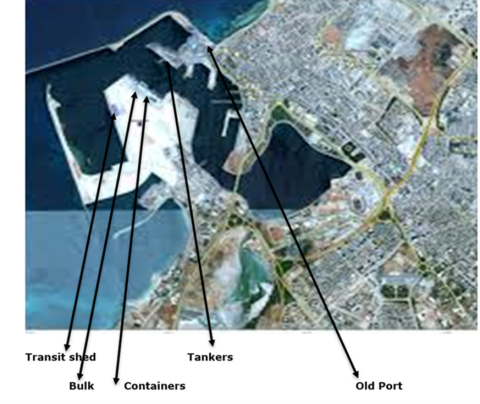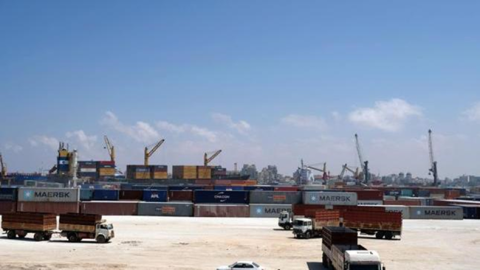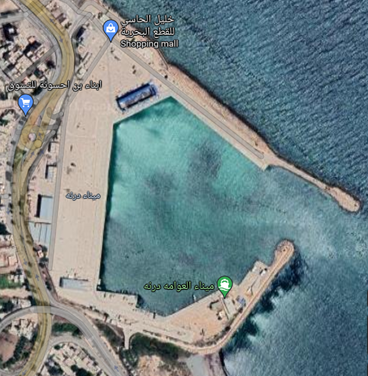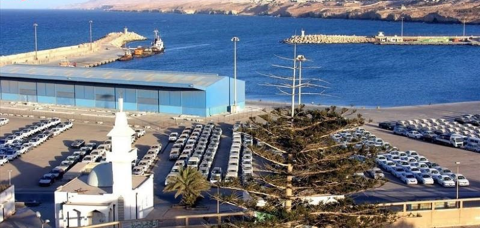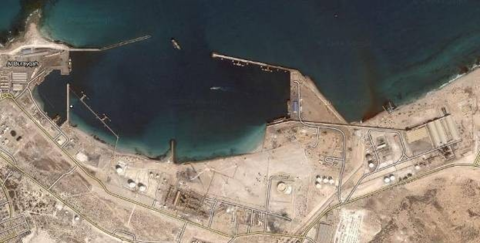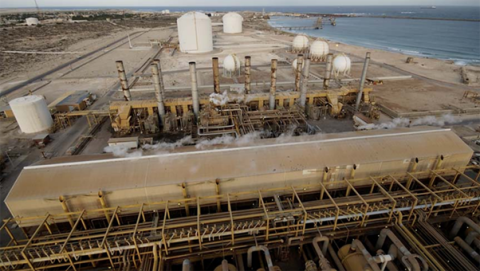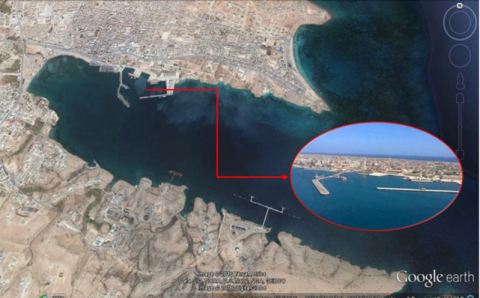Libya - 2.1 Libya Port Assessment
Overview
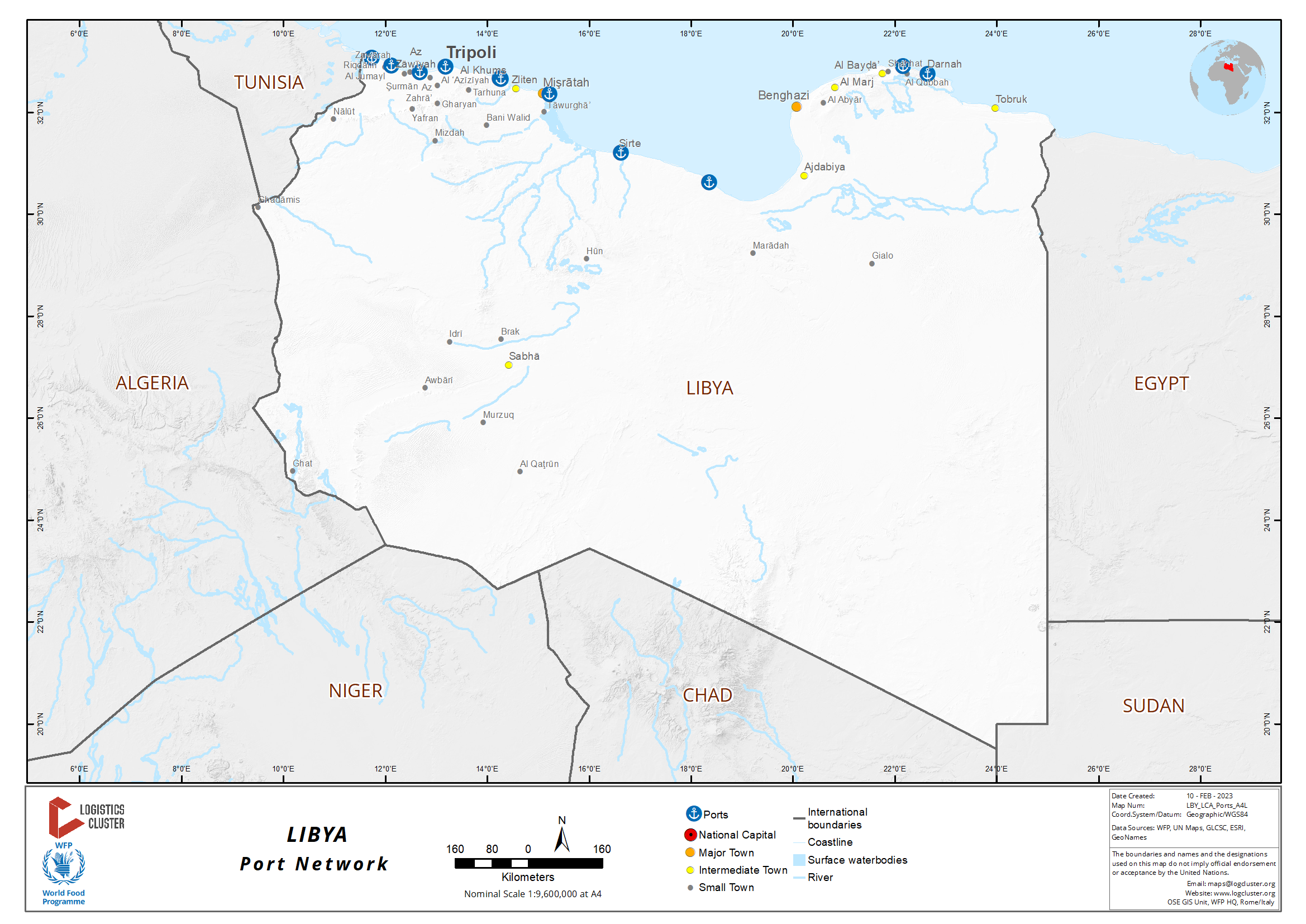
There are four main commercial seaports in western Libya: Tripoli, Khoms, Misratah and Zwarah seaports, while in eastern Libya there are two main seaports, Benghazi and Tobruk seaports. Also, there are two small seaports in the eastern region: Al-Braiga Port and Port of Derna.
Libya - 2.1.1 Port of Tripoli
Port Overview
The Port of Tripoli is the main sea port in Tripoli, the capital of Libya, and one of the oldest ports in the Mediterranean. It is managed and operated by the "Libyan Ports Company", and handles different types of products: containerized and bulk cargoes, livestock, chemical and oils…etc.
The port is protected by two breakwaters of 2,000 and 700 meters, the harbour covers about 500 hectares, and can accommodate vessels to 190 meters long with maximum draft of 11.5 meters; the maximum annual capacity is about 4.5 million tons.
Port website: N/A, Ports and Maritime Transport Authority website: https://www.lma.ly
Key port information may also be found at: http://www.maritime-database.com
|
Port Location and Contact |
|
|---|---|
|
Country |
Libya |
|
Province or District |
Tripoli |
|
Nearest Town or City with Distance from Port |
Tripoli City The port is located close to the downtown |
|
Port's Complete Name |
Port of Tripoli |
|
Latitude |
32.903916 |
|
Longitude |
13.178740 |
|
Managing Company or Port Authority |
Libyan Ports Company https://lpclibya.com/ |
|
Management Contact Person |
Eng. Musbah Taher Habibi |
|
Nearest Airport and Airlines with Frequent International Arrivals/Departures |
Mitiga Airport – MJI - Libyan airlines - Afriqiyah Airways - Buraq Air - Libyan wings - Global Aviation and Services Group |
Port Picture

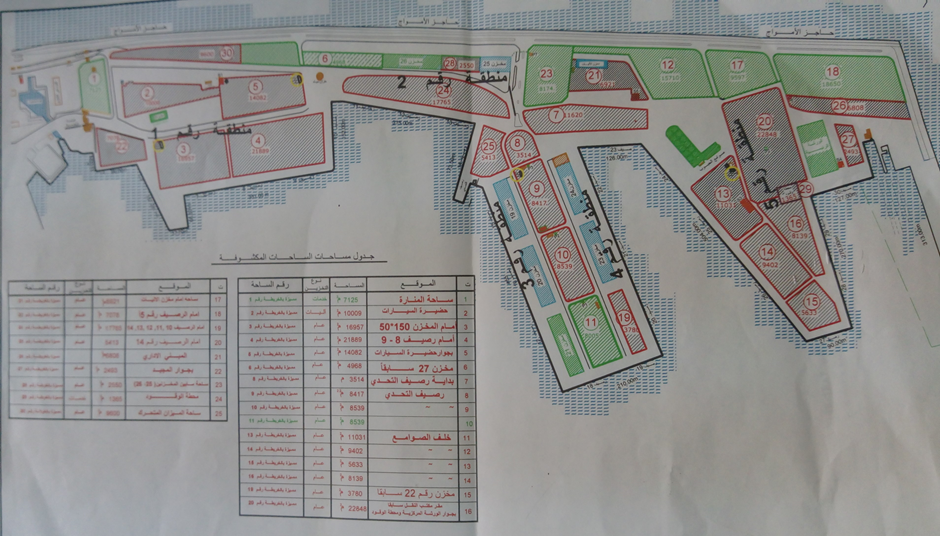
- Zone1 includes: Storage area 1 & Berths 5, W6, 6, 6E, 7, 8, and 9.
- Zone2 includes: Storage area 2 & Berths 10, 11, 12, 13, and 14.
- Zone3 includes: Storage area 3 & Berths 15, 16, 17, and 18.
- Zone4 includes: Storage area 4 & Berths 19, 20, 21, 22, and 23.
- Zone5 includes: Storage area 5 & Berths 24, 25, 26, 27, 28, 29, 30, and 31.
Description and Contacts of Key Companies
Tripoli port Managed and operated by The Libyan Ports Company.
For more information on port contacts, please see the following link:
4.4 Port and Waterways Companies Contact List
Port Performance
The channel draft at the port is 12m maximum, and vessels with max 11.5m depth can access.
The port generally is not congested, cargo moves smoothly in the port, and there is no delay for the coming vessels. The average waiting time between arrival and berthing is few hours to one day maximum; priority is given to humanitarian cargo.
|
Seasonal Constraints |
||
|---|---|---|
|
|
Occurs |
Time Frame |
|
Rainy Season |
Yes |
From November to March |
|
Major Import Campaigns |
N/A |
|
|
Handling Figures for 2020 |
|
|---|---|
|
Vessel Calls |
389 Vessels |
|
Container Traffic (TEUs) |
58,935 |
|
Handling Figures Bulk and Break Bulk for 2020 |
|
|---|---|
|
Bulk (mt) |
856,348 |
|
Break bulk (mt) |
303,214 |
Discharge Rates and Terminal Handling Charges
Based on the information collected during the mission to the port:
Bulk handling charges: 5.3 LYD/m3
Break bulk handling charges: 50.00 LYD / Container (20 ft and 40 ft have the same rate)
|
Approx. Total Tripoli Port tariff / container |
|||
|---|---|---|---|
|
Weeks |
20 ft (33.2 CBM) |
40 ft (76.3 CBM) |
40 ft (88.4 CBM) |
|
1st |
300 |
600 |
620 |
|
2nd |
320 |
639 |
662 |
|
3rd |
360 |
716 |
749 |
|
4th |
435 |
871 |
922 |
|
5th |
513 |
1025 |
1094 |
Berthing Specifications
|
Type of Berth |
Quantity |
Length (m) |
Maximum Draft (m) |
|---|---|---|---|
|
Conventional Berth |
1 |
37.7 |
10.5 |
|
Container Berth |
30 |
3,875.8 |
10.5 |
|
Silo Berth |
6 |
910.0 |
10.5 |
|
Berthing Tugs |
30 |
3,875.8 |
10.5 |
|
Water Barges |
N/A |
|
|
Please visit this website for more info: http://www.lma.ly/ta3memat/ports/tipoli.pdf
General Cargo Handling Berths
|
Cargo Type |
Berth Identification |
|---|---|
|
Imports - Bagged Cargo |
All berths could be used |
|
Exports - Bagged Cargo |
All berths could be used |
|
Imports and Exports - RoRo |
Berth No. 6 used for Ro-Ro |
Port Handling Equipment
The port equipment is managed by the governmental company Libyan Ports Company.
|
Equipment |
Available
|
Total Quantity and Capacity Available |
Comments on Current Condition and Actual Usage |
|---|---|---|---|
|
Dockside Crane |
Yes |
4 |
Good |
|
Tugs |
Yes |
7 |
Good |
|
Container Gantries |
No |
|
|
|
Mobile Cranes 1 |
Yes |
4 |
With a load of 60 tons 100 tons |
|
Mobile Cranes 2 |
Yes |
6 |
With a load of 50 tons |
|
Reachstacker |
Yes |
20 |
Good |
|
RoRo Tugmaster (with Trailer) |
Yes |
14 |
Good |
|
Grain Elevator with Bagging Machines 1 |
Yes |
3 |
Capacity 250 600 tons / hour |
|
Grain Elevator without Bagging Machines 2 |
Yes |
6 |
Capacity of 180 tons / hour |
|
Transtainer |
No |
|
|
|
Forklifts |
Yes |
29 |
Good |
|
linking Boat |
Yes |
2 |
|
|
Pollution Control Boat |
Yes |
1 |
|
|
Floating cranes |
Yes |
2 |
|
|
Pilot Boat |
Yes |
3 |
|
Container Facilities
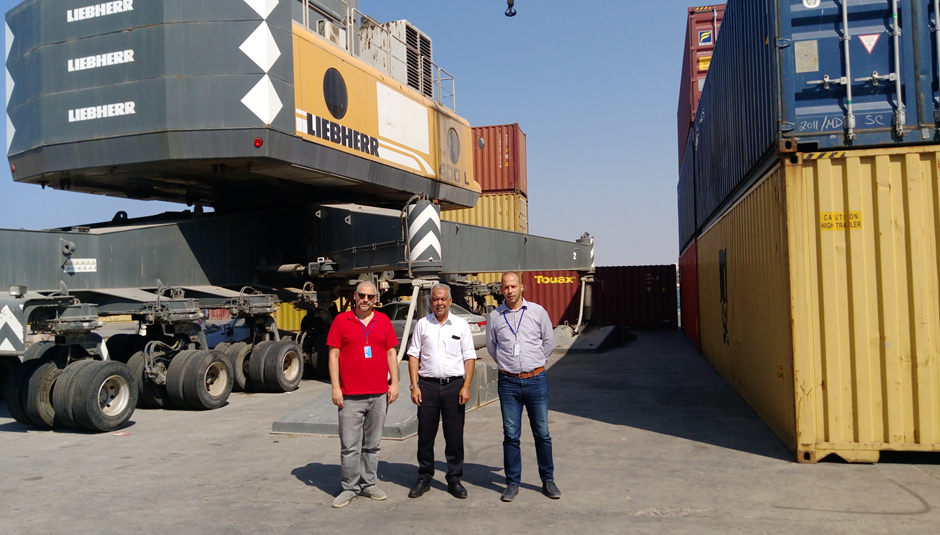
|
Facilities |
20 ft |
40 ft |
|---|---|---|
|
Container Facilities Available |
Five mixed storage areas for 20 &40 ft. |
Five mixed storage areas for 20 &40 ft. |
|
Container Freight Station (CFS) |
Five mixed storage areas for 20 &40 ft. |
Five mixed storage areas for 20 &40 ft. |
|
Refrigerated Container Stations |
One storage area containing 250 electricity plugs which can supply max. 250 reefers with total storage space area about 11,620.00 m2. |
The same for 40 ft containers. |
|
Other Capacity Details |
Preparing new area to be used as a new storage for 20 & 40 ft, working in this area is suspended till now. |
|
|
Daily Take Off Capacity |
Max. capacity is 2500 Containers 20 & 40 ft per day |
|
|
Number of Reefer Stations |
One storage area containing 250 electricity plugs which can supply max. 250 reefers with total storage space area about 11,620.00 m2. |
|
|
Emergency Take-off Capacity |
About 2500 Containers 20 &40 ft per day. |
|
|
Off take Capacity of Gang Shift |
N/A |
|
Customs Guidance
According to the national legislation, all humanitarian cargos are exempted from duties and taxes. Exemption letter/certificate should be obtained from MOFA and to be sent to port authority prior to shipment arrival.
Once the custom clearance agent provides all clearance documents and finalize the normal process, the shipment will be temporary released, and transported (the shipment would be escorted by custom police) to the organization’s warehouse. Normally it takes from 1 to 3 working days to temporally clear the shipment.
In the temporary release case, the warehouse will be sealed by Libyan customs until the Food and Drug Control Centre FDCC release the final sampling results and approve that the cargo is in compliance with Libyan standards.
The port working hours: From Sunday to Thursday, 7:00 am to 6:00 pm. The port still running limited activities out of the working hours and holidays, based on the need.
For more information on customs in Libya, please see the following link:
Terminal Information
MULTIPURPOSE TERMINAL
Tripoli port has one out of service passenger’s terminal for many years, no operating plan published by government till this moment.
RORO facilities: Berth no. 6 as it shown above is used for RoRo shipments, Using the same mentioned storage areas.
GRAIN AND BULK HANDLING
The available handling option at the port is to discharge Grain and Bulk directly to Trucks or any mobile tanks to store it out-side of the port, the grain storage facility that available at the port already fully occupied and used by different governmental company.
MAIN STORAGE TERMINAL
The main storage facilities as the following:
- Two indoor Areas for bagged cargo about 3,780.00 m2 about 10,070.00 m3.
- A space and electricity plugs only for 250 Reefer size of 40 ft containers can be available to store refrigerated cargo total area is about 11,620.00 m2.

|
Storage Type |
Number of Storage Facilities |
Area (m2) |
|---|---|---|
|
Bagged Cargo |
Two indoor warehouses |
3780 |
|
Refrigerated Cargo |
A space with and electricity plugs only for 250 Reefer size of 40 ft containers |
11620 |
|
General Cargo |
Five outdoor storage areas |
213,529 |
Stevedoring
Port Operated by one governmental company "Libyan Ports Company”, total amount of laborers about 750 employees, about 550 on ground operation and handling, and about 200 are Managing all the port facilities and activities.
Hinterland Information
All Cleared items are moved out of the port by private trucks. The trucks are categorized by size, type, each truck has a sequence number, and all are recorded in a waiting list. The trucks movement process is managed by the Union of Trucks.
Port Security
Port located close to downtown at the north coast of Tripoli, 24/7 security guards at the main gates and 3 patrol fast boats. Equipped with Surveillance cameras covers all storage areas.
There have been no attacks at the port within 2018, and the risks to vessels conducting operations at the port is assessed to be low.
|
Security |
|
|---|---|
|
ISPS Compliant |
Yes |
|
Current ISPS Level |
2 |
|
Police Boats |
Yes |
|
Fire Engines |
Yes |
2021 Tripoli Port Pictures:
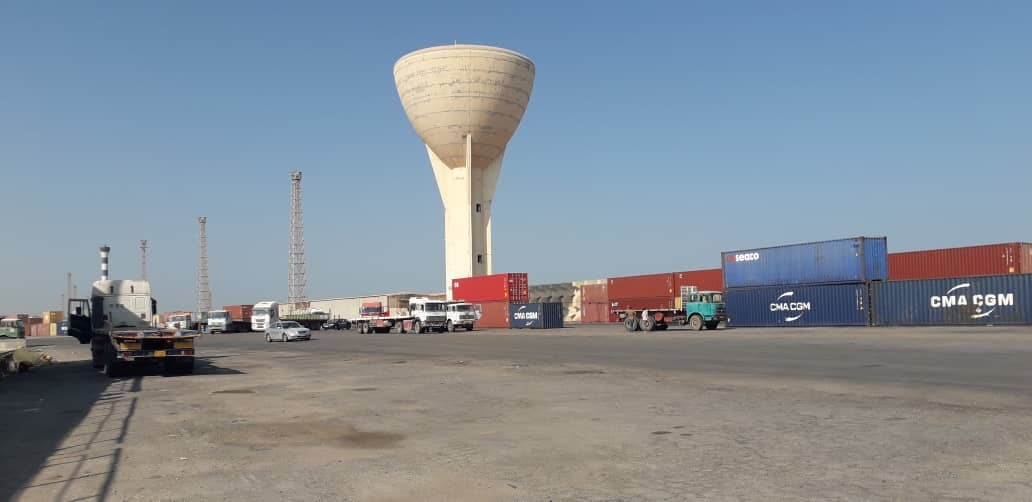
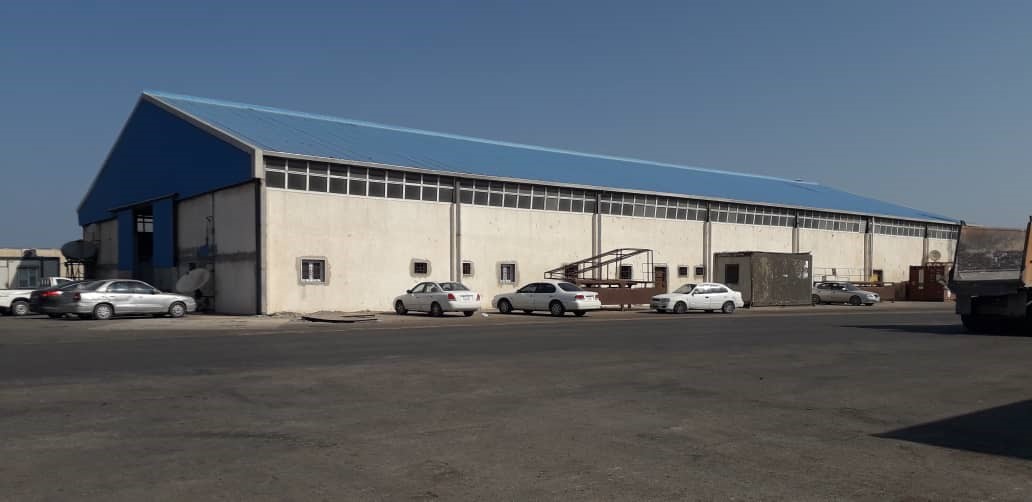

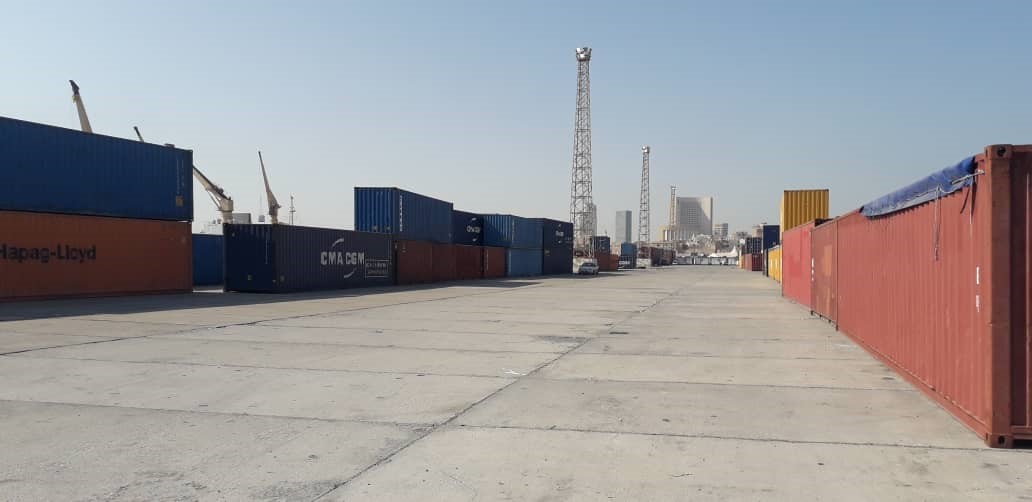
Libya - 2.1.2 Libya Port of Benghazi
Port Overview
The Port of Benghazi is one of the biggest ports in Libya, located in the eastern side of Libya on the Mediterranean coast, with total size: 4,400,000 m². The port is managed by the Libyan Ports Company. The Port of Benghazi resumed operations in October 2017, having suspended operations in 2014, due to internal disruptions. The infrastructure is in workable condition, navigation and buoys are in place. Up until 2007, the Port of Benghazi was the primary gateway for the inward traffic of humanitarian cargo destined to the operations in Sudan and Chad.
The port consists of:
- The old harbour: it contains nine berths (1-9) for receiving general cargo, containers and berthing tugs, the “Old Port “is no longer in use due to infrastructural damage.
- Juliana harbour: It contains nine berths (10-18) for receiving general cargo and containers, silos, direct delivery goods and bulk items.
The port working hours: From Saturday to Thursday, 7:00 to 18:00. The port still runs limited activities outside of the working hours and during holidays, based on the need.
Key port information may be found at: http://www.maritime-database.com
|
Port Location and Contact |
|
|---|---|
|
Country |
Libya |
|
Province or District |
Benghazi |
|
Nearest Town or City with Distance from Port |
Benghazi 8.4 km |
|
Port's Complete Name |
Port of Benghazi |
|
Latitude |
32.112778 |
|
Longitude |
20.040000 |
|
Managing Company or Port Authority |
Libyan Port Company |
|
Management Contact Person |
Hussein Al Sharaa |
|
Nearest Airport and Airlines with Frequent International Arrivals/Departures |
Benghazi Airport Only Libyan airlines depart and arrive from/to the airport |
Port Picture
Description and Contacts of Key Companies
The Port of Benghazi is managed and operated by the Libyan Ports Company.
For more information on port contacts, please see the following link: 4.4 Port and Waterways Companies Contact List
Port Performance
Channel draft is 12.5 m maximum; 11 m vessel depth can access. The port is not currently congested. Humanitarian shipments are given priority at the port. The port has no major limitations/bottlenecks.
The dedicated port shed, located on the quay side, remains structurally sound, repairs are required to the roof, side panels and the sliding doors. The operating structure requires an infusion of cargo handling equipment, warehouse, and terminal space. All the quay walls have new and serviceable fenders which are in good condition. The average waiting time between arrival and berthing is three days.
The “Old Port “is no longer in use due to infrastructural damage.
|
Seasonal Constraints |
||
|---|---|---|
|
Occurs |
Time Frame |
|
|
Rainy Season |
Yes |
From November to March |
|
Major Import Campaigns |
No |
|
|
Handling Figures for 2020 |
|
|---|---|
|
Vessel Calls |
536 |
|
Container Traffic (TEUs) |
59,794 TEU |
|
Handling Figures Bulk and Break Bulk for 2020 |
|
|---|---|
|
Bulk (mt) |
854,678 including container volume |
|
Break bulk (mt) |
898,222 including container volume |
Discharge Rates and Terminal Handling Charges
The port tariffs, as advised by the Port Management, are low compared to the other ports of the region, and government subsidies are in place.
On one hand the lower port rates endeavour to keep the costs of the commodities imported into Libya at an affordable rate, however conversely, there is no mechanism in the rates structure or operating budgets to include a percentage for the purchase of equipment, structured maintenance and the development through training of the human capital. The tariffs are very low, being established back to the 1980s. The below table illustrates open yard container storage tariff in Libyan ports in 2020.
|
Weeks |
Aprox.Total Port tarifs / container |
||
|
20 ft (33.2 m³) |
40 ft (76.3 m³ |
40 ft (88.4 m³) |
|
|
1st |
300 |
600 |
620 |
|
2nd |
320 |
639 |
662 |
|
3rd |
360 |
716 |
749 |
|
4th |
435 |
871 |
922 |
|
5th |
513 |
1,025 |
1,094 |
Berthing Specifications
|
Type of Berth |
Quantity |
Length (m) |
Maximum Draft (m) |
|---|---|---|---|
|
Conventional Berth |
2 |
160 |
6 |
|
Container Berth |
5 |
805 |
8 |
|
Silo Berth |
1 |
170 |
8 |
|
Water Barges |
8.5 |
General Cargo Handling Berths
|
Cargo Type |
Berth Identification |
|---|---|
|
Imports - Bagged Cargo |
898,222 mt |
|
Exports - Bagged Cargo |
NA |
|
Imports and Exports - RoRo |
NA |
|
Other Imports |
854,678 mt bulk |
Port Handling Equipment
The port equipment is managed by the government. The Port of Benghazi is managed and operated by the Libyan Ports Company.
|
Equipment |
Available |
Total Quantity and Capacity Available |
Comments on Current Condition and Actual Usage |
|---|---|---|---|
|
Dockside Crane |
No |
||
|
Container Gantries |
No |
||
|
Mobile Cranes |
Yes |
2 |
Liebherr Mobile cranes (75 mt and 100 mt) |
|
Reachstacker |
Yes |
14 |
45 mt and 12 mt capacity |
|
RoRo Tugmaster (with Trailer) |
Yes |
9 |
45 mt and 60 mt capacity |
|
Grain Elevator with Bagging Machines |
Yes |
11 |
capacity 300 mt per hour and grain ship pneumatic conveyor 120 tons per hour |
|
Transtainer |
No |
The only way to offload containers is by mobile crane |
|
|
Forklifts |
Yes |
19 |
7 mt, 12 mt, and 3 mt |
|
Tugs |
Yes |
5 |
|
|
Mooring Boat |
Yes |
1 |
|
|
Floating cranes |
Yes |
1 |
|
Container Facilities
|
Facilities |
20 ft and 40 ft |
|---|---|
|
Container Facilities Available |
1 yard for 20 ft and 40 ft |
|
Container Freight Station (CFS) |
1 |
|
Refrigerated Container Stations |
Up to 100 stations |
|
Daily Take Off Capacity |
100-150 TEUs |
|
Number of Reefer Stations |
Up to 100 stations |
|
Emergency Take-off Capacity |
150 TEUs |
|
Off take Capacity of Gang Shift |
NA |
Customs Guidance
According to the national legislation, all humanitarian cargos are exempted from duties and taxes. Exemption letter/certificate should be obtained from MOFA and sent to port authority prior to shipment arrival.
Once the custom clearance agent provides all clearance documents and finalizes the normal process, the shipment will be temporarily released, and transported (the shipment would be escorted by custom police) to the organization’s warehouse. Normally it takes from one to three working days to temporarily clear the shipment.
The warehouse will be closed and sealed until the Food and Drug Control Centre tests the commodities and confirms the compliance of the shipment with Libyan standards, thus, issuing the final release.
For more information on customs in Libya, please see the following link: 1.3 Customs Information
Terminal Information
MULTIPURPOSE TERMINAL
Benghazi Port berths’ main activity is receiving general cargo / containers / livestock / oil. Libya’s Ports and Maritime Transport Authority put forward a proposal of the Benghazi marine passenger terminal and yacht marina to local investment.
GRAIN AND BULK HANDLING
The available handling option at the port is to discharge grain and bulk directly to trucks or any mobile tanks to store it outside of the port.
Ship-shore bulk handling equipment are located at berth 7. The most significant traffic is liquid bulk, through tankers. Dry bulk consists mostly of grain and cement.
MAIN STORAGE TERMINAL
|
Storage Type |
Number of Storage Facilities |
Area (m2) |
|---|---|---|
|
Bagged Cargo |
1 |
7500 m² |
|
Refrigerated Cargo |
N/A |
|
|
General Cargo |
1 |
7500 m² |
Stevedoring
The Port of Benghazi is operated by a governmental company, the Libyan Ports Company.
Hinterland Information
All cleared items are moved out of the port by private trucks. The trucks are categorized by size and type, each truck has a sequence number, and all are recorded in a waiting list. The trucks movement process is managed by the Union of Trucks.
Port Security
The port i said to be International Ships and Port Security (ISPS) compliant, presently undergoing an ISPS Audit Level 2.
|
Security |
|
|---|---|
|
ISPS Compliant |
Yes |
|
Current ISPS Level |
2 |
|
Police Boats |
Yes |
|
Fire Engines |
No |
2.1.3 Libya Port of Derna
Port Overview
Derna is a port city in eastern Libya, with a population of about 80,000. The city is located between Benghazi and Tobruk and it has a unique environment among Libyan cities, as is located at the eastern end of the Jebel Akhdar, (the green mountains). The Port of Derna is a medium-sized port and vessels entering the port have a maximum length of 33 meters.
In 2021, the port returned opeartional after about three years of closing as a direct result of the prevailing security situation in Derna.
Port working hours: from Sunday to Thursday, 7:00 to 18:00.
The port still running limited activities out of the working hours and holidays, based on the need.
Port website: Port of Derna Website
Key port information may also be found at: http://www.maritime-database.com
|
Port Location and Contact |
|
|---|---|
|
Country |
Libya |
|
Province or District |
Derna City |
|
Nearest Town or City with Distance from Port |
Tubrok 165 km |
|
Port's Complete Name |
Darnah Seaport |
|
Latitude |
32.761008° |
|
Longitude |
22.656081° |
|
Managing Company or Port Authority |
The Libyan Ports Company /The Socialist Company for Ports |
|
Management Contact Person |
Mr Ibrahim Saleh Lyas |
|
Nearest Airport and Airlines with Frequent International Arrivals/Departures |
Abraq National Airport - Libyan Airlines - Afriqiyah Airways - Buraq Air |
Port Picture
- Containers & cars storage open yard;
- Cargo storage area Indoor/Warehouse. Completely demolished.
Description and Contacts of Key Companies
The Port of Derna is managed and operated by The Libyan Ports Company.
For more information on port contacts, please see the following link:
4.4 Libya Port and Waterways Company Contact List
Port Performance
The largest draft of ship that can be received is 7.5m. The port usually not congested. The average waiting time between arrival and berthing is from few hours to one or two days maximum, however, the priority is given to humanitarian assistance.
|
Seasonal Constraints |
||
|---|---|---|
|
Occurs |
Time Frame |
|
|
Rainy Season |
Yes |
From November to March |
|
Major Import Campaigns |
N/A |
|
|
Other Comments |
None |
|
Discharge Rates and Terminal Handling Charges
The following information has been collected from the Libyan Ports Company.
Bulk handling charges: 5.3 LYD/m3 .
Break bulk handling charges: 50.00 LYD / Container (20 ft and 40 ft have the same rate).
|
Approx. Total Port tariff / container |
|||
|---|---|---|---|
|
Weeks |
20 ft (33.2 m3) |
40 ft (76.3 m3) |
40 ft (88.4 m3) |
|
1st |
300 |
600 |
620 |
|
2nd |
320 |
639 |
662 |
|
3rd |
360 |
716 |
749 |
|
4th |
435 |
871 |
922 |
|
5th |
513 |
1025 |
1094 |
Berthing Specifications
|
Type of Berth |
Quantity |
Length (m) |
Maximum Draft (m) |
|---|---|---|---|
|
Conventional Berth |
2 |
160 |
6 |
|
Container Berth |
5 |
805 |
8 |
|
Silo Berth |
1 |
170 |
8 |
General Cargo Handling Berths
|
Cargo Type |
Berth Identification |
|---|---|
|
Imports - Bagged Cargo |
All berths could be used |
|
Exports - Bagged Cargo |
All berths could be used |
Port Handling Equipment
|
Equipment |
Available |
Total Quantity and Capacity Available |
|---|---|---|
|
Dockside Crane |
No |
|
|
Container Gantries |
No |
|
|
Mobile Cranes |
Yes |
4 |
|
Reachstacker |
Yes |
1 |
|
RoRo Tugmaster (with Trailer) |
Yes |
3 |
|
Grain Elevator with Bagging Machines |
Yes |
4 |
|
Transtainer |
No |
|
|
Forklifts |
Yes |
15 |
Container Facilities
The port has 5 open yards to store containers.
|
Facilities |
20 ft |
40 ft |
|---|---|---|
|
Container Facilities Available |
5 |
|
|
Container Freight Station (CFS) |
N/A |
|
|
Refrigerated Container Stations |
N/A |
|
|
Other Capacity Details |
3 warehouses of 40,000 m³ |
|
|
Daily Take Off Capacity |
N/A |
|
|
Number of Reefer Stations |
N/A |
|
|
Emergency Take-off Capacity |
500 |
500 |
|
Off take Capacity of Gang Shift |
N/A |
N/A |
Customs Guidance
According to the national legislation, all humanitarian cargos are exempted from duties and taxes. Exemption letter/certificate should be obtained from Ministry Of Foreign Affairs And International Collaboration (MOFA) and to be sent to port authority prior to shipment arrival.
Once the custom clearance agent provides all clearance documents and finalize the normal process, the shipment will be temporary released and transported (the shipment would be escorted by custom police) to the organization’s warehouse. Normally, it takes from one to three working days to temporary clear the shipment.
In the temporary release case, the warehouse will be sealed by Libyan customs until the Food and Drug Control Centre (FDCC) release the final sampling results and approve that the cargo is in compliance with Libyan standards.
Terminal Information
MULTIPURPOSE TERMINAL
The Port of Derna has one passenger’s terminal, however out of service since many years. No operating plan has been published by government.
GRAIN AND BULK HANDLING
The available handling option at the port is to discharge grain and bulk directly to trucks or any mobile tanks to store it out-side of the port.
MAIN STORAGE TERMINAL
The main storage facilities as the following:
|
Storage Type |
Number of Storage Facilities |
Area (m2) |
|---|---|---|
|
Bagged Cargo |
3 |
4,800 |
|
Refrigerated Cargo |
N/A |
|
|
General Cargo |
5 |
220,000 |
Hinterland Information
All cleared items are moved out of the port by private trucks. The trucks are categorized by size and type. Each truck has a sequence number and all recorded in a waiting list. The trucks movement process is managed by the Union of Trucks.
Port Security
The Port has a 25/7security guards located at the main gates.
2.1.4 Libya Port of Al-Braiga
Port Overview
Al-Braiga port also known as Mersa Brega or Marsa al-Brega is Mediterranean port on the Gulf of Sidra in north-eastern Libya, the port is a major commercial oil port with an artificial harbour and several offshore berths which can handle tankers up to VLCC size as well as general cargo and RoRo vessels. The port is owned and operated by the Sirte Oil company a subsidiary of the National Oil Corporation and its primary use is an oil terminal.
Port working hours: from Sunday to Thursday, 7:00 to 18:00.
The port still running limited activities out of the working hours and holidays, based on the need.
Key port information may also be found at: http://www.maritime-database.com
|
Port Location and Contact |
|
|---|---|
|
Country |
Libya |
|
Province or District |
Brega |
|
Nearest Town or City with Distance from Port |
Ajdabiya 75 km |
|
Port's Complete Name |
Marsa al-Brega |
|
Latitude |
30.409028° |
|
Longitude |
19.590611° |
|
Managing Company or Port Authority |
Sirt Oil Company |
|
Management Contact Person |
Mr. Mohamed Alhoni |
|
Nearest Airport and Airlines with Frequent International Arrivals/Departures |
Marsa Brega Airport |
Port Picture
Description and Contacts of Key Companies
The port of Al-Braiga is managed and operated by the Sirt Oil Company.
For more information on port contacts, please see the following link:
4.4 Libya Port and Waterways Company Contact List
Port Performance
The largest draft of ship that can be received is 10 m. The port is small and never congested. The average waiting time, between arrival and berthing, is from few hours to one or two days maximum, however, the priority is given to humanitarian assistance.
|
Seasonal Constraints |
|||
|---|---|---|---|
|
Occurs |
Time Frame |
||
|
Rainy Season |
Yes |
From November to March |
|
|
Major Import Campaigns |
No |
||
|
Other Comments |
None |
||
|
Handling Figures for 2020 |
|||
|
Vessel Calls |
14 |
||
|
Container Traffic (TEUs) |
667 |
||
|
Handling Figures Bulk and Break Bulk for 2020 |
|
|---|---|
|
Bulk (mt) |
N/A |
|
Break bulk (mt) |
48,394 |
Discharge Rates and Terminal Handling Charges
The following is based on the information collected from the Libyan Port Company.
Bulk handling charges: 5.3 LYD/m3 .
Break bulk handling charges: 50.00 LYD / Container (20 ft and 40 ft have the same rate).
|
Approx. Total Port tariff / container |
|||
|---|---|---|---|
|
Weeks |
20 ft (33.2 m3) |
40 ft (76.3 m3) |
40 ft (88.4 m3) |
|
1st |
300 |
600 |
620 |
|
2nd |
320 |
639 |
662 |
|
3rd |
360 |
716 |
749 |
|
4th |
435 |
871 |
922 |
|
5th |
513 |
1025 |
1094 |
Berthing Specifications
|
Type of Berth |
Quantity |
Length (m) |
Maximum Draft (m) |
Comments |
|---|---|---|---|---|
|
Conventional Berth |
2 |
380 |
10 |
|
|
Container Berth |
2 |
740 |
10 |
|
Port Handling Equipment
|
Equipment |
Available |
Total Quantity and Capacity Available |
|---|---|---|
|
Dockside Crane |
No |
|
|
Container Gantries |
No |
|
|
Mobile Cranes |
Yes |
30 tons |
|
Reachstacker |
No |
|
|
RoRo Tugmaster (with Trailer) |
No |
|
|
Grain Elevator with Bagging Machines |
No |
|
|
Transtainer |
No |
|
|
Forklifts |
Yes |
12 |
Container Facilities
Basically, Sirt Oil Company operates an off-shore oil terminal. The primary types of cargo handled in Port of Al-Braiga are crude oil, oil and petrochemical products as well as some general cargo.
Customs Guidance
According to the national legislation, all humanitarian cargos are exempted from duties and taxes. Exemption letter/certificate should be obtained from MOFA and to be sent to port authority prior to shipment arrival.
Once the custom clearance agent provides all clearance documents and finalize the normal process, the shipment will be temporary released, and transported (the shipment would be escorted by custom police) to the organization’s warehouse. Normally it takes from 1 to 3 working days to temporally clear the shipment.
In the temporary release case, the warehouse will be sealed by Libyan customs until the Food and Drug Control Centre FDCC release the final sampling results and approve that the cargo is in compliance with Libyan standards.
For more information on customs in Libya, please see the following link:
Terminal Information
MULTIPURPOSE TERMINAL
The port has no passenger’s terminal.
GRAIN AND BULK HANDLING
There is no available handling equipment to discharge grain and bulk at this port.
MAIN STORAGE TERMINAL
The available storage facilities at this port are oil tanks and open yards.
Hinterland Information
All cleared items are moved out of the port by private trucks. The trucks are categorized by size and type. Each truck has a sequence number and all recorded in a waiting list. The trucks movement process is managed by the Union of Trucks.
Port Security
The port has 24/7 security guards at the main gates and the port is equipped with firefighting system.
|
Security |
|
|---|---|
|
ISPS Compliant |
Yes |
|
Current ISPS Level |
2 |
|
Police Boats |
Yes |
|
Fire Engines |
Yes |
Libya - 2.1.5 Libya Port of Misrata
Port Overview
Port of Misrata, also known as Port of Qasr Ahmed, is one of the most important ports in Libya due to its location and developed equipment. It is a commercial port serving Misrata city and the neighbouring cities, and it has been ranked as one of the best-operated seaports in Libya. The port has become a main destination for many international transport lines. The port capacity is 6,000,000 MT per year, with a maximum draft of 12m and a total berth length of 3,550m. The port includes a free zone established in 1978, with a total area of 300 ha. The port receives different types of commodities such as food, livestock, containers, petroleum, and oil products. The port is currently under a process of development and modernization with the objective of constructing additional berths with a total length of 2,250m, draft of 13m, to be able to receive 4 million containers per year. Misrata port is including a free zone. The port & Free zone are connected directly to the main highway by the heavy transportation road without crossing the city centre.
Port website: http://www.mfzly.com/en/
Key port information may also be found at: http://www.maritime-database.com
|
Port Location and Contact |
|
|---|---|
|
Country |
Libya |
|
Province or District |
Misrata |
|
Nearest Town or City with Distance from Port |
Misrata city about 12 km |
|
Port's Complete Name |
Misrata Seaport |
|
Latitude |
32.362183° |
|
Longitude |
15.219106° |
|
Managing Company or Port Authority |
Misrata free zone |
|
Management Contact Person |
Ezzeddin Alhussein Zableh |
|
Nearest Airport and Airlines with Frequent International Arrivals/Departures |
Misrata Airport 1. Libyan airlines 2. Afriqiyah Airways 3. Buraq Air 4. Libyan wings |
Port Picture

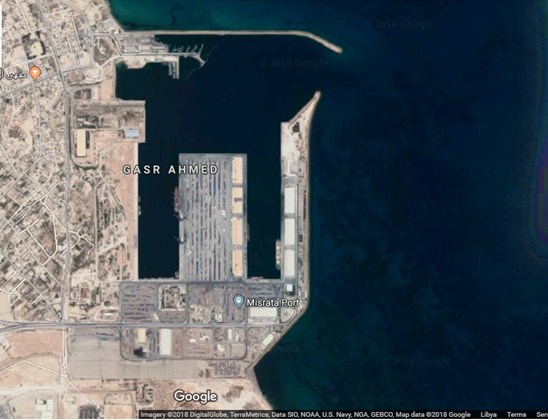
Description and Contacts of Key Companies
Misrata Port is managed and operated by The Misrata Free Zone.
For more information on port contacts, please see the following link:
4.4 Libya Port and Waterways Company Contact List
Port Performance
The channel draft at the port is 13 m maximum, and vessels with maximum 11 m depth can access. The port generally is not congested, cargoes move smoothly in the port and there is no delay for the coming vessels. No waiting time between arrival and berthing, also the priority is given to the humanitarian cargos. Mt includes the volume of the containers.
|
Seasonal Constraints |
||
|---|---|---|
|
Occurs |
Time Frame |
|
|
Rainy Season |
Yes |
From November to March |
|
Major Import Campaigns |
No |
|
|
Other Comments |
None |
|
|
Handling Figures for 2020 |
|
|---|---|
|
Vessel Calls |
1132 |
|
Container Traffic (TEUs) |
213,302 |
|
Handling Figures Bulk and Break Bulk for 2020 |
|
|---|---|
|
Bulk (mt) |
947,734 |
|
Break bulk (mt) |
2,265,782 |
Discharge Rates and Terminal Handling Charges
For information on port rates and charges, please see the following link: http://www.mfzly.com/en/services
Main charges of the handling (storage fees are not included):
- Container 20 ft / 100.00 LYD
- Container 40 ft / 200.00 LYD
Berthing Specifications
|
Type of Berth |
Quantity |
Length (m) |
Maximum Draft (m) |
Comments |
|---|---|---|---|---|
|
Conventional Berth |
10 |
1854 |
11 |
|
|
Container Berth |
10 |
2195 |
12 |
10A, 11,11A, 12, 13, 14, 16 |
|
Silo Berth |
2 |
400 |
11 |
4, 5 |
|
Berthing Tugs |
5 |
|
||
|
Water Barges |
N/A |
11 |
These services provided by shipping agencies |
Please visit the following link that showing the available berths and for more information: http://www.mfzly.com/en/
General Cargo Handling Berths
|
Cargo Type |
Berth Identification |
|---|---|
|
Imports - Bagged Cargo |
10A, 11, 11A, 12,13,14 |
|
Exports - Bagged Cargo |
10A, 11, 11A, 12,13,14 |
|
Imports and Exports - RoRo |
1,2,7 |
|
Other Imports |
Port Handling Equipment
The port managed by the Government.
|
Equipment |
Available |
Total Quantity and Capacity Available |
Comments on Current Condition and Actual Usage |
|---|---|---|---|
|
Dockside Crane |
Yes |
4 |
|
|
Container Gantries |
Yes |
4 |
(2 RTG) & (2 STS). |
|
Mobile Cranes |
Yes |
11 |
(60-100) tons |
|
Reachstacker |
Yes |
12 |
45 tons capacity and 5 containers height |
|
RoRo Tugmaster (with Trailer) |
Yes |
4 |
|
|
Grain Elevator with Bagging Machines |
Yes |
3 |
|
|
Transtainer |
No |
||
|
Forklifts |
Yes |
17 |
3,5,7,12.5 tons |
|
Tugboats |
Yes |
5 |
Tugboats |
|
Pilot Boat |
Yes |
2 |
Pilot Boat |
|
Marine survey boat |
Yes |
1 |
Marine survey boat |
Container Facilities
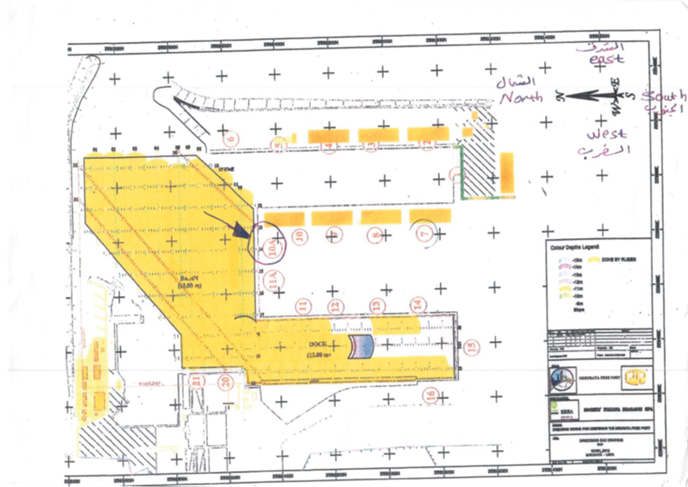
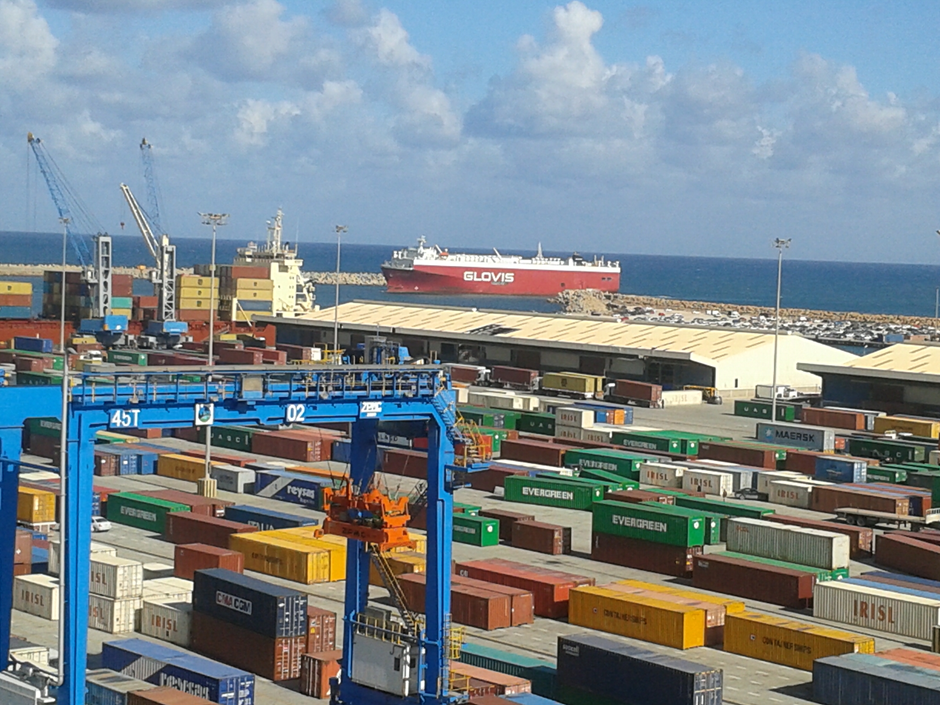
The port has been ranked as one of the best operated Libyan seaports and has become a popular destination for many international transport lines, continuing the following storage facilities:
- Open storage yards of 60 hectares.
- Covered storage warehouses of 67,500 square meters.
- Grain silo with 40,000-ton capacity.
|
Facilities |
20 ft |
40 ft |
|---|---|---|
|
Container Facilities Available |
Open storage yards of 60 hectares |
|
|
Container Freight Station (CFS) |
6 |
|
|
Refrigerated Container Stations |
||
|
Other Capacity Details |
Covered storage warehouses of 67,500 square meters |
|
|
Daily Take Off Capacity |
Maximum capacity is 3000 Container 20&40 ft per day |
|
|
Number of Reefer Stations |
500 connection points for 20 ft & 40 ft |
|
|
Emergency Take-off Capacity |
Up to 3000 container 20&40 ft. per day |
|
|
Off take Capacity of Gang Shift |
||
Customs Guidance
According to the national legislation, all humanitarian cargos are exempted from duties and taxes. Exemption letter/certificate should be obtained from MOFA and sent to port authority prior to shipment arrival.
Once the custom clearance agent provides all clearance documents and finalize the normal process, the shipment will be temporary released, and transported (the shipment would be escorted by custom police) to the organization’s warehouse. Normally it takes from 1 to 3 working days to temporally clear the shipment.
The warehouse will be closed and sealed until the Food and Drug Control Centre tests the commodities and confirms the compliance of the shipment with Libyan standards, thus, issuing the final release.
The port customs working hours: From Saturday to Thursday, 8:00 am to 3:00 pm. The customs will keep running with limited activities out of the working hours and holidays, based on the need.
National legislation: General policy of humanitarian aids (for example: decreases, regulation, exempting aid from import duties and taxes, if certain types of goods are not duty & tax free) Humanitarian cargos are duties and taxes free.
A permission from Ministry of Foreign Affairs is required to get duties and taxes waived.
Required documents:
- 1x original and 1x copy of Bill of Lading
- 1x original of commercial Invoice in English
- 1x original Certificate of Origin Certified by Chamber of Commerce.
- 1x master packing list
For more information on customs in Libya, please see the following link:
Terminal Information
MULTIPURPOSE TERMINAL
RORO facilities: Berth and storage area are available.
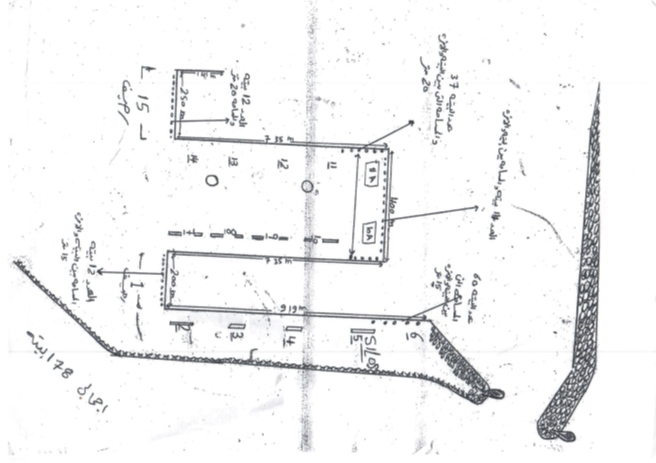
GRAIN AND BULK HANDLING
The available handling option at the port is to discharge Grain and Bulk directly to Trucks or any mobile tanks to store it out-side of the port.6, also, a grain silo with 40,000-ton capacity is available at port.
MAIN STORAGE TERMINAL
Inside storage are 9 warehouses with total of 67,000 m²
Open storage yards with capacity of 60 hectares.
Silo with available capacity up to 40,000 ton.
|
Storage Type |
Number of Storage Facilities |
Area (m2) |
|---|---|---|
|
Bagged Cargo |
6 |
67,500 m2 |
|
Refrigerated Cargo |
Up to 500 units |
|
|
General Cargo |
60 ha |
Hinterland Information
All Cleared items are moved out of the port by private trucks. The trucks are categorized by size, type, each truck has a sequence number, and all are recorded in a waiting list. The trucks movement process is managed by the Union of Trucks
Port Security
Port is 24/7 security guards at the main gates patrol fast boats. Equipped with Surveillance cameras covers all storage areas. and the risks to vessels conducting operations at the port is assessed to be low.
|
Security |
|
|---|---|
|
ISPS Compliant |
Yes |
|
Current ISPS Level |
2 |
|
Police Boats |
Yes |
|
Fire Engines |
Yes |
Libya - 2.1.6 Libya Port of Al Khoms
Port Overview
Al Khoms is a medium-sized Port. The port was built on an area of 249 hectares. The types of vessels regularly calling at Khoms are Container Ship (34%), Bulk Carrier (15%), Oil/Chemical Tanker (9%), Fishing Vessel (4%). The maximum length of the vessels recorded to having entered this port is 187 meters. The maximum draught is 11 meters.
Al Khoms is located at West Mediterranean; it is also known as Khoms. The port itself consists of 20th medium sized berths with lengths ranging from 75 to 1900 meters and maximum drafts ranging from 10.5 to 11.5 meters depending on the berth. The port is well organized, functioning well.
Port website: https://lpclibya.com/
Key port information may also be found at: http://www.maritime-database.com
|
Port Location and Contact |
|
|---|---|
|
Country |
Libya |
|
Province or District |
Al Khoms |
|
Nearest Town or City with Distance from Port |
Khoum’s city 0.00 km |
|
Port's Complete Name |
ميناء الخمس البحري Port of Al Khoms |
|
Latitude |
32.676056° |
|
Longitude |
14.241278° |
|
Managing Company or Port Authority |
Libyan Ports Company |
|
Management Contact Person |
Mr. Omar Almenshaz |
|
Nearest Airport and Airlines with Frequent International Arrivals/Departures |
Misratah International Airport MRA - Libyan Airlines - Afriqiyah Airways - Libyan wings Airlines - Buraq Air Global Aviation and Services Group |
Port Picture
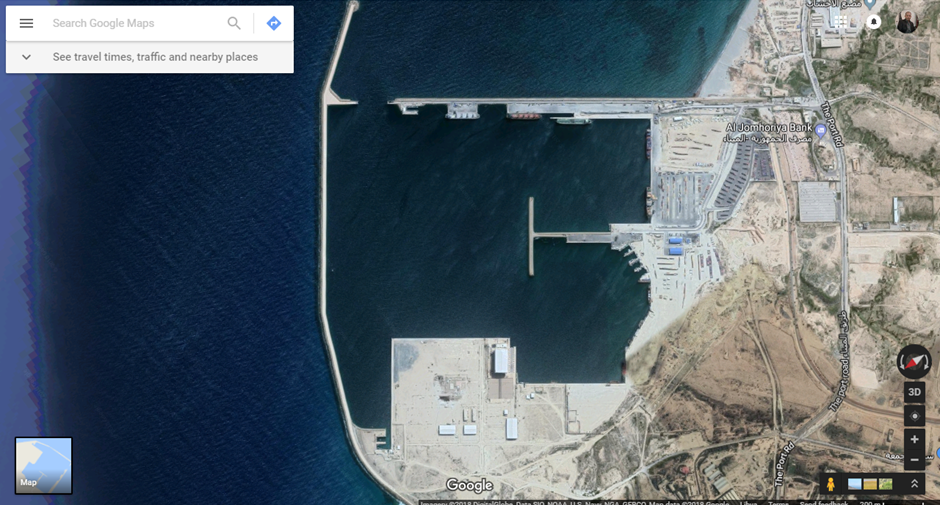
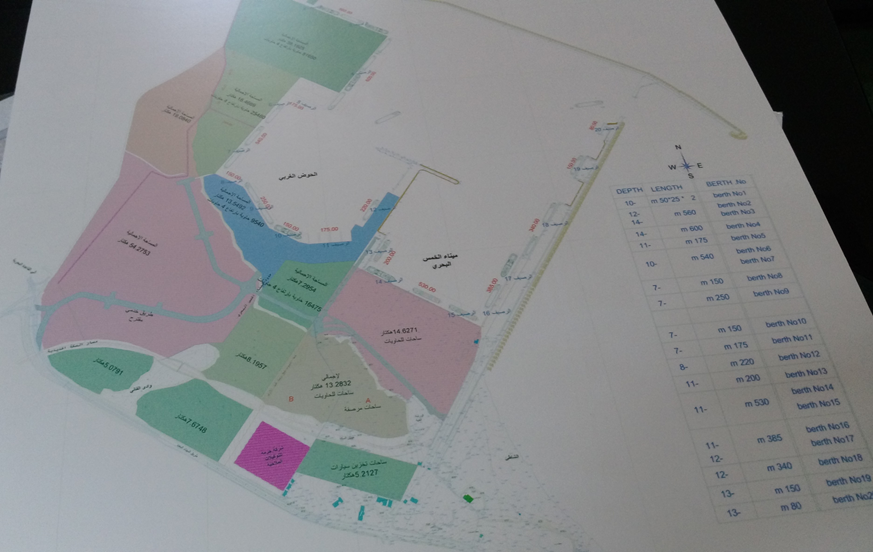
As illustrated above, the port consists of 20 berths (sequentially named from 1 to 20), and 11 storage areas. The main and paved storage area is the one located close to berths 14 &15. About 15 hectares in/outdoor.
Description and Contacts of Key Companies
Libyan Ports Company is managing and operating the port.
For more information on port contacts, please see the following link:
4.4 Libya Port and Waterways Company Contact List
Port Performance
Al Khoms port is one of the important ports in Western Libya, and is widely used for commercial purpose, so the port is generally congested, and the time between arrival and berthing is from 2 hours to 2 days (depends on the congestion), however the port management gives the priority to the humanitarian cargos, so no significant delay is expected.
The channel draft is 16m with maximum 11m vessel depth that can access, and the cargo-handling MTs includes the volume and weight of the containers.
|
Seasonal Constraints |
||
|---|---|---|
|
Occurs |
Time Frame |
|
|
Rainy Season |
Yes |
From November to March |
|
Major Import Campaigns |
No |
|
|
Other Comments |
None |
|
|
Handling Figures for 2020 |
|
|---|---|
|
Vessel Calls |
334 |
|
Container Traffic (TEUs) |
80,593 |
|
Handling Figures Bulk and Break Bulk for 2020 |
|
|---|---|
|
Bulk (mt) |
585,208 |
|
Break bulk (mt) |
203,873 |
Discharge Rates and Terminal Handling Charges
The following is based on the collected information from port authorities.
Bulk: 5.5 LYD/m3
Break bulk: 50.00 LYD / Container (20 ft and 40 ft have the same rate)
|
Approx. Total Port tariff / container |
|||
|---|---|---|---|
|
Weeks |
20 ft (33.2 CBM) |
40 ft (76.3 CBM) |
40 ft (88.4 CBM) |
|
1st |
300 |
600 |
620 |
|
2nd |
320 |
639 |
662 |
|
3rd |
360 |
716 |
749 |
|
4th |
435 |
871 |
922 |
|
5th |
513 |
1025 |
1094 |
Berthing Specifications
|
Type of Berth |
Quantity |
Length (m) |
Maximum Draft (m) |
Comments |
|---|---|---|---|---|
|
Conventional Berth |
5 berths |
920 |
10.5 |
Berths, 6, 7, 12, 10, & 18 |
|
Container Berth |
3 berths |
730 |
10.5 |
Berths, 13, 14, & 15 |
|
Silo Berth |
N/A |
Direct delivery, no available storage area, using Vacuum to off-load – 600 MT-hr |
||
|
Berthing Tugs |
2 |
32 |
4 |
3500 hr & 2800 hr power |
|
Water Barges |
None |
These services provided by shipping agencies. |
General Cargo Handling Berths
|
Cargo Type |
Berth Identification |
|---|---|
|
Imports - Bagged Cargo |
All can be used |
|
Exports - Bagged Cargo |
All can be used |
|
Imports and Exports - RoRo |
Berth No.6 |
|
Other Imports |
Port Handling Equipment
The port equipment is managed by a governmental company, Libyan Port Company.
|
Equipment |
Available |
Total Quantity and Capacity Available |
Comments on Current Condition and Actual Usage |
|---|---|---|---|
|
Dockside Crane |
No |
||
|
Container Gantries |
No |
||
|
Mobile Cranes |
Yes |
3 |
In Good condition |
|
Reachstacker |
Yes |
3 |
In Good condition |
|
RoRo Tugmaster (with Trailer) |
Yes |
16 |
In Good condition |
|
Grain Elevator with Bagging Machines |
Yes |
23 |
In Good condition |
|
Transtainer |
Yes |
2 |
In Good condition |
|
Forklifts |
No |
Container Facilities
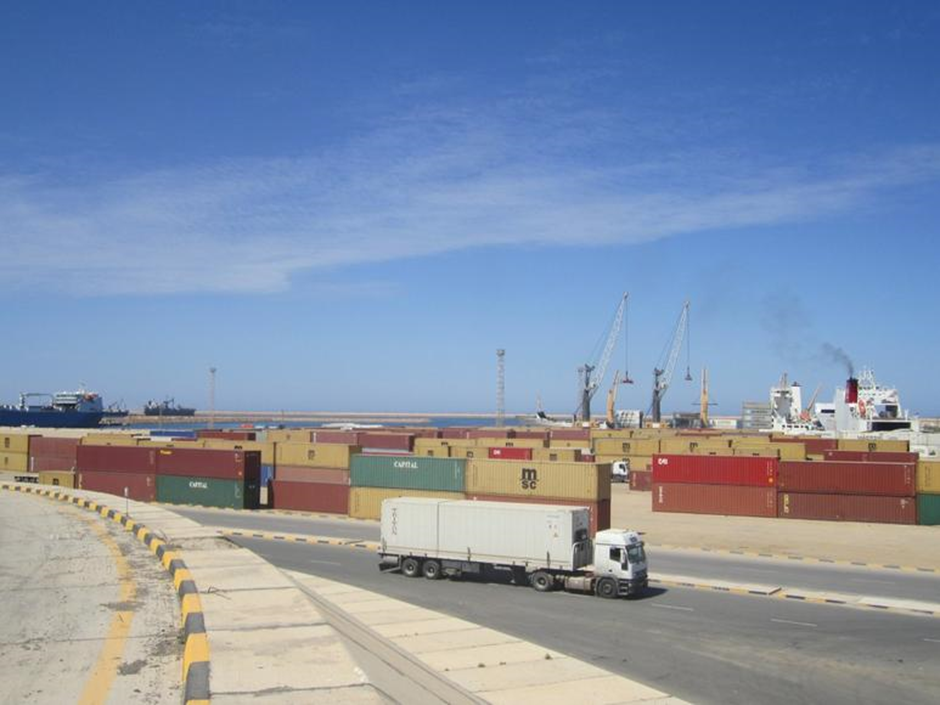
|
Facilities |
20 ft |
40 ft |
|---|---|---|
|
Container Facilities Available |
One main storage area about 15 Hectares for 20 & 40 ft containers. |
|
|
Container Freight Station (CFS) |
One main storage area about 15 Hectares for 20 & 40 ft containers. |
|
|
Refrigerated Container Stations |
One storage station for 20 &40 ft containers able to receive 520 refrigerated containers. |
|
|
Other Capacity Details |
Other unpaved storage areas used to store cars and animals. |
|
|
Daily Take Off Capacity |
300 – 400 containers. |
|
|
Number of Reefer Stations |
Three storage areas containing 520 electricity plugs can supply max. 520 reefers with total storage space area about 15,000.00 m2. |
|
|
Emergency Take-off Capacity |
450 containers in total. |
|
|
Off take Capacity of Gang Shift |
N/A |
|
Customs Guidance
According to the national legislation, all humanitarian cargos are exempted from duties and taxes. Exemption letter/certificate should be obtained from MOFA and sent to port authority prior to shipment arrival.
Once the custom clearance agent provides all clearance documents and finalize the normal process, the shipment will be temporary released, and transported (the shipment would be escorted by custom police) to the organization’s warehouse. Normally it takes from 1 to 3 working days to temporally clear the shipment.
The warehouse will be closed and sealed until the Food and Drug Control Centre tests the commodities and confirms the compliance of the shipment with Libyan standards, thus, issuing the final release.
Required documents:
I- Original Certificate of origin attested by Chamber of commerce of at the country of origin. Customs may request to translate it to Arabic language;
II- Original Invoice. Customs may request to translate it to Arabic language;
III- Packing List. Customs may request to translate it to Arabic language;
IV- Delivery order issued by ship liner.
Hours of operation:
Mainly working hours: from Saturday to Thursday, from 7:00 to 19:00. However, the port might continue functioning out of working hours in emergency situations.
The Customs offices located out of the port borders. Working hours from Sunday to Thursday 9:00 to 14:00.
For more information on customs in Libya, please see the following link:
Terminal Information
MULTIPURPOSE TERMINAL
RoRO facilities: Berth no. 6 can be used for RoRo shipments, using the same main storage area.
GRAIN AND BULK HANDLING
The available handling option at the port is to discharge Grain and Bulk directly to Trucks or any mobile tanks to store it out-side of the port, there is no grain storage facility at the port.
MAIN STORAGE TERMINAL
The main and paved storage area is the one located close to berths 14 &15. (about 15 hectares). No Indoor warehouses available in the port, the main storage are outdoor areas.
|
Storage Type |
Number of Storage Facilities |
Area (m2) |
|---|---|---|
|
Bagged Cargo |
Three indoor warehouses total CBM can stored about 51,840 m3. |
|
|
Refrigerated Cargo |
Using the same 3 storage areas that containing 520 electricity plugs can connect max. 520 reefers with total storage space area. |
15,000 |
|
General Cargo |
Stevedoring
The port is operated by one governmental company Libyan Ports Company, total amount of laborers is about 1000 employees, about 800 on ground operation and handling and about 200 are managing all the port facilities and activities.
Hinterland Information
All cleared items are moved out of the port by private trucks. The trucks are categorized by size, type, each truck has a sequence number, and all are recorded in a waiting list. The trucks movement process is managed by the Union of Trucks.
Port Security
Port located close to the downtown at the north coast of Al Khoms, 24/7 security guarded are available at the main gates, in addition to 3 patrol fast boats. Surveillance cameras covers all storage areas.
There have been no attacks at the port, and the risks to vessels conducting operations at the port is assessed to be low.
|
Security |
|
|---|---|
|
ISPS Compliant |
Yes |
|
Current ISPS Level |
2 |
|
Police Boats |
Yes |
|
Fire Engines |
Yes |
2.1.7 Libya Port of Tobruk
Port Overview
The Port of Tobruk is a port located at Tobruk, Libya. Start operating in 1986, it is located in Eastern Libya near the Egyptian border - about 450 km (280 mi) east of Benghazi. The entrance to the main channel into the port is between Tobruk point ( 32.066667°, 24.016667°) and the point of Marsa Ummash Shawush .
As a result of the Libyan Civil War, the port was temporarily closed due to clashes between protestors and government forces and reopened on 28 February 2011 for oil exports. The port re-opened soon after the civil war ended. As of August 2014, all port traffic from the Port of Benghazi is diverted to the port of Tobruk due to the closure of the port in Benghazi as a direct result of the prevailing security situation in Libya.
The port working hours: from Saturday to Thursday, 7:00 to 18:00.
The port still running limited activities out of the working hours and holidays, based on the need.
Port website: http://www.lma.ly/
Key port information may also be found at: http://www.maritime-database.com
|
Port Location and Contact |
|
|---|---|
|
Country |
Libya |
|
Province or District |
Tobruk |
|
Nearest Town or City with Distance from Port |
Tobruk 1.5 km |
|
Port's Complete Name |
Port of Tobruk |
|
Latitude |
32.07675° |
|
Longitude |
23.980889° |
|
Managing Company or Port Authority |
Libyan Port Company |
|
Management Contact Person |
Mohammed Fayaz |
|
Nearest Airport and Airlines with Frequent International Arrivals/Departures |
Tobruk Airport Only Libyan Airlines depart and arrive to the airport (Buraq. Afriaqia. Al burniq ) |
Port Picture
Description and Contacts of Key Companies
Tobruk Port is managed and operated by The Libyan Ports Company – Eastern coast.
For more information on port contacts, please see the following link:
4.4 Port and Waterways Companies Contact List
Port Performance
As of August 2014, all port traffic from the Port of Benghazi is diverted to the Port of Tobruk due to the closure of the Port in Benghazi as a direct result of the prevailing security situation in Libya.
The port has ten anchorages, with a six-vessel capacity each.
|
Seasonal Constraints |
||
|---|---|---|
|
Occurs |
Time Frame |
|
|
Rainy Season |
Yes |
From October to March |
|
Major Import Campaigns |
No |
|
|
Other Comments |
A Mediterranean type of climate prevails. The rainy season is from October to March with heavy showers of rain only along the narrow coast in the northern part of Libya. Issues to consider for Bulk shipping operations. |
|
|
Handling Figures for 2020 |
|
|---|---|
|
Vessel Calls |
76 |
|
Container Traffic (TEUs) |
1,366 |
|
Handling Figures Bulk and Break Bulk for 2020 |
|
|---|---|
|
Bulk (mt) |
232,926 |
|
Break bulk (mt) |
38,519 |
Discharge Rates and Terminal Handling Charges
The port tariffs, as advised by the Port Management, are low compared to the other ports of the region, and government subsidies are in place.
On one hand the lower port rates endeavour to keep the costs of the commodities imported into Libya at an affordable rate, however conversely, there is no mechanism in the rates structure or operating budgets to include a percentage for the purchase of equipment, structured maintenance and the development through training of the human capital. The tariffs are very low, being established back to the 1980s. The below table illustrates open yard container storage tariff in Libyan ports in 2020.
|
Weeks |
Approx.Total Port tariff / container |
||
|---|---|---|---|
|
20 ft (33.2 m³ ) |
40 ft (76.3 m³) |
40 ft (88.4 m³) |
|
|
1st |
300 |
600 |
620 |
|
2nd |
320 |
639 |
662 |
|
3rd |
360 |
716 |
749 |
|
4th |
435 |
871 |
922 |
|
5th |
513 |
1025 |
1094 |
Berthing Specifications
|
Type of Berth |
Quantity |
Length (m) |
Maximum Draft (m) |
|---|---|---|---|
|
Conventional Berth |
5 |
600 |
7 |
|
Container Berth |
4 |
800 |
8 |
Port Handling Equipment
Port equipment is managed by the government.
|
Equipment |
Available |
Total Quantity and Capacity Available |
Comments on Current Condition and Actual Usage |
|---|---|---|---|
|
Dockside Crane |
No |
||
|
Container Gantries |
No |
||
|
Mobile Cranes |
Yes |
2 |
50 mt and 100 mt |
|
Reachstacker |
Yes |
2 |
5x45 mt capacity |
|
RoRo Tugmaster (with Trailer) |
Yes |
2 |
5x45 tons capacity |
|
Grain Elevator with Bagging Machines |
Yes |
2 |
1x 1 Grain ship pneumatic conveyor 120 mt per hour |
|
Transtainer |
Yes |
2 |
45 mt |
|
Forklifts |
Yes |
10 |
Container Facilities
|
Facilities |
20 ft |
40 ft |
|---|---|---|
|
Container Facilities Available |
90000 m2 open yard to store 20 ft & 40 ft |
|
|
Other Capacity Details |
2000 m2 to store dangerous goods |
|
|
Emergency Take-off Capacity |
150 |
150 |
Customs Guidance
According to the national legislation, all humanitarian cargos are exempted from duties and taxes. Exemption letter/certificate should be obtained from MOFA and sent to port authority prior to shipment arrival.
Once the custom clearance agent provides all clearance documents and finalizes the normal process, the shipment will be temporarily released, and transported (the shipment would be escorted by custom police) to the organization’s warehouse. Normally it takes from one to three working days to temporarily clear the shipment.
The warehouse will be closed and sealed until the Food and Drug Control Centre tests the commodities and confirms the compliance of the shipment with Libyan standards, thus, issuing the final release.
For more information on customs in Libya, please see the following link:
Terminal Information
MULTIPURPOSE TERMINAL
Tobruk port berths main activity is receiving General Cargo / Containers / Molding / Livestock / Oil Quay.
GRAIN AND BULK HANDLING
The available handling option at the port is to discharge grain and bulk directly to trucks or any mobile tanks to store it outside of the port.
MAIN STORAGE TERMINAL
|
Storage Type |
Number of Storage Facilities |
Area (m2) |
|---|---|---|
|
Bagged Cargo |
2 |
1,800 |
|
Refrigerated Cargo |
N/A | |
|
General Cargo |
1 |
50000 |
Stevedoring
The Port of Tobruk is operated by a governmental company, the Libyan Ports Company.
Hinterland Information
All cleared items are moved out of the port by private trucks. The trucks are categorized by size and type, each truck has a sequence number, and all are recorded in a waiting list. The trucks movement process is managed by the Union of Trucks,
Port Security
The port i said to be International Ships and Port Security (ISPS) compliant, presently undergoing an ISPS Audit Level 2.
|
Security |
|
|---|---|
|
ISPS Compliant |
Yes |
|
Current ISPS Level Level 2 = Heightened, Level 3 = Exceptional) |
2 |
|
Police Boats |
Yes |
|
Fire Engines |
No |
Libya - 2.1.8 Port of Zuwara
Port Overview
Marsa Zuwara is the seaport of Zuwara town, a busy coastal town situated 110 km west of Tripoli, and about 40 km east of the Tunisian border. The town has a small airport, mainly used by the government and which will be developed into an international airport as part of the Zuwara Free Trade Zone.
Port website: http://www.lma.ly/
Key port information may also be found at: http://www.maritime-database.com
|
Port Location and Contact |
|
|---|---|
|
Country |
Libya |
|
Province or District |
Zuwara |
|
Nearest Town or City with Distance from Port |
Zuwara city 0.00 km |
|
Port's Complete Name |
Zuwara Sea port |
|
Latitude |
32.925011° |
|
Longitude |
12.119361° |
|
Managing Company or Port Authority |
Libyan Ports Company/ Socialist Company for Ports |
|
Management Contact Person |
+218 51 627910-15 / 615400 - 623745 |
|
Nearest Airport and Airlines with Frequent International Arrivals/Departures |
Zuwara National Airport (about 40 km East), Tripoli International Airport (110 km East). |
Port Picture
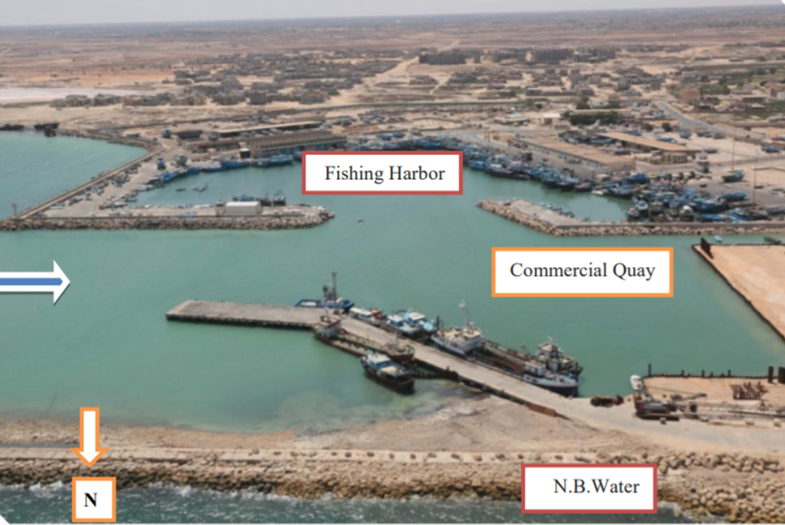
As it shown in the picture above, the commercial port consists of 2 berths 4m deep a floaty jetty can accommodate vessel up to 65m in length max draft 5.0m anchorage.
Description and Contacts of Key Companies
Libyan Ports Company. Managing and operating the port.
For more information on port contacts, please see the following link:
4.4 Port and Waterways Companies Contact List
Port Performance
The largest vessel that the port can accommodate is 65m in length and max draft 5.0m anchorage. The port is not congested. The port max capacity is approximately 200,000 tons per year.
|
Seasonal Constraints |
||
|---|---|---|
|
Occurs |
Time Frame |
|
|
Rainy Season |
Yes |
From October to March |
|
Major Import Campaigns |
No |
|
|
Other Comments |
|
|
|
Handling Figures for 2020 |
|
|---|---|
|
Vessel Calls |
7 |
|
Container Traffic (TEUs) |
52 |
|
Handling Figures Bulk and Break Bulk for 2020 |
|
|---|---|
|
Bulk (mt) |
0 |
|
Break bulk (mt) |
300 |
Discharge Rates and Terminal Handling Charges
The port tariffs as advised by the Port Management to be low compared to the other ports of the region, there is an inherited concept of cross government subsidy.
On one hand the lower port rates endeavour to ensure and keep the costs of the landed commodities to Libya at an affordable rate (debatable as Libya is an expensive country), however conversely, there is no mechanism in the rates structure or operating budgets to include a percentage for the purchase of equipment, structured maintenance and as important the development through training of the human capital. The tariffs are very low, being established back to the 1980s, however, the below table illustrates open yard container storage tariff in Libyan ports in 2020.
|
Weeks |
Aprox.Total Port tariff / container |
||
|---|---|---|---|
|
20 ft (33.2 CBM) |
40 ft (76.3 CBM) |
40 ft (88.4 CBM) |
|
|
1st |
300 |
600 |
620 |
|
2nd |
320 |
639 |
662 |
|
3rd |
360 |
716 |
749 |
|
4th |
435 |
871 |
922 |
|
5th |
513 |
1025 |
1094 |
Berthing Specifications
|
Type of Berth |
Quantity |
Length (m) |
Maximum Draft (m) |
Comments |
|---|---|---|---|---|
|
Conventional Berth |
2 |
65 |
5 |
|
Port Handling Equipment
The port equipment is managed by the Government.
|
Equipment |
Available |
Total Quantity and Capacity Available |
Comments on Current Condition and Actual Usage |
|---|---|---|---|
|
Dockside Crane |
No |
||
|
Container Gantries |
No |
||
|
Mobile Cranes |
Yes |
1 |
|
|
Reachstacker |
Yes |
1 |
|
|
RoRo Tugmaster (with Trailer) |
Yes |
1 |
|
|
Grain Elevator with Bagging Machines |
No |
||
|
Transtainer |
No |
||
|
Forklifts |
Yes |
10 |
Container Facilities
|
Facilities |
20 ft |
40 ft |
|---|---|---|
|
Container Facilities Available |
24000 |
|
|
Container Freight Station (CFS) |
28000 |
|
|
Refrigerated Container Stations |
1 storage station for 20 &40 ft containers able |
|
|
Other Capacity Details |
Other unpaved storage areas used to store cars. |
|
|
Daily Take Off Capacity |
N/A |
|
|
Number of Reefer Stations |
||
|
Emergency Take-off Capacity |
|
|
|
Off take Capacity of Gang Shift |
Customs Guidance
According to the national legislation, all humanitarian cargos are exempted from duties and taxes. Exemption letter/certificate should be obtained from MOFA and sent to port authority prior to shipment arrival.
Once the custom clearance agent provides all clearance documents and finalize the normal process, the shipment will be temporary released, and transported (the shipment would be escorted by custom police) to the organization’s warehouse. Normally it takes from 1 to 3 working days to temporally clear the shipment.
The warehouse will be closed and sealed until the Food and Drug Control Centre tests the commodities and confirms the compliance of the shipment with Libyan standards, thus, issuing the final release.
For more information on customs in Libya, please see the following link:
Terminal Information
MULTIPURPOSE TERMINAL
RoRO facilities: Berth no.2 can be used for RoRo shipments, using the same main storage area.
GRAIN AND BULK HANDLING
The available handling option at the port is to discharge Grain and Bulk directly to Trucks or any mobile tanks to store it out-side of the port, there is no grain storage facility at the port.
MAIN STORAGE TERMINAL
The main and paved storage area is the one located close to berths 2. No Indoor warehouses available in the port, the main storage are outdoor areas.
|
Storage Type |
Number of Storage Facilities |
Area (m2) |
|---|---|---|
|
Bagged Cargo |
N/A |
|
|
Refrigerated Cargo |
Using the same 1 Storage areas that containing 520 electricity plugs can connect Max. 520 reefers with total storage space area. |
2,000 |
|
General Cargo |
Stevedoring
The port is Operated by one governmental company, Libyan Ports Company. The total amount of laborers is about 150 employees, about 70 on ground operation and handling, and about 80 are managing all the port facilities and activities.
Hinterland Information
All cleared items are moved out of the port by private trucks. The trucks are categorized by size, type, each truck has a sequence number, and all are recorded in a waiting list. The trucks movement process is managed by the Union of Trucks.
Port Security
Port located close to the downtown at the north coast of Zuwara, 24/7 security guarded are available at the main gates, in addition to 2 patrol fast boats. Surveillance cameras covers all storage areas.
There have been no attacks at the port within 2020, and the risks to vessels conducting operations at the port is assessed to be low.
|
Security |
|
|---|---|
|
ISPS Compliant |
Yes |
|
Current ISPS Level Level 2 = Heightened, Level 3 = Exceptional) |
2 |
|
Police Boats |
Yes |
|
Fire Engines |
Yes |
